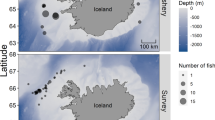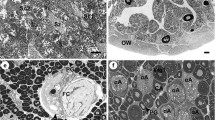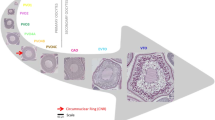Abstract
This study investigates the reproductive strategy, an important component in the estimation of stock reproductive potential, in Norwegian spring-spawning (NSS) herring (Clupea harengus), an iteroparous, extreme capital spawner, through the estimation of fecundity over a period of 3 years including two complete maturation cycles and three spawning seasons. NSS herring have an ‘optimistic’ strategy, with almost all adult herring caught in August being in the vitellogenic stage of ovary development, despite overwintering energy levels not being determined at this time. Fecundity in the summer, i.e., more than half a year before spawning in spring (February–April), was also much higher than could be supported by an individual’s concurrent energy levels. Consequently, fecundity was later reduced through atresia with the majority of this occurring before overwintering. The total reduction and the length of the time period in which the reduction took place appeared to vary between years. During the spawning season, atresia was mostly prevalent in small first-time spawners <180 g and several individuals aborted ovary development at this time. Final fecundity varied between years with a difference of up to 18% and was linked to annual variations in condition. In conclusion, this extensive field study has demonstrated that each individual herring can display a suite of size-specific reproductive tactics to fine-tune oocyte production in response to fluctuating levels of planktonic prey.







Similar content being viewed by others
References
Andersen TE (2003) Unbiased stereological estimation of cell numbers and volume fractions: the disector and the principles of points counting. In: Kjesbu OS, Hunter J, Witthames PR (eds) Modern approaches to assess maturity and fecundity of warm- and cold-water fish and squids. Institute of Marine Research, Norway, pp 11–18
Cardinale M, Arrhenius F (2000) Decreasing weight-at-age of Atlantic herring (Clupea harengus) from the Baltic Sea between 1986 and 1996: a statistical analysis. ICES J Mar Sci 57:882–893
Davidson D, Marshall CT (2010) Are morphometric indices accurate indicators of stored energy in herring Clupea harengus? J Fish Biol 76:913–929
Dragesund O (1970) Distribution, abundance and mortality of young and adolescent Norwegian spring spawning herring (Clupea harengus, Linne) in relation to subsequent year class strength. Fiskdir skr Ser havunders 15:451–556
Dragesund O, Hamre J, Ulltang Ø (1980) Biology and population dynamics of the Norwegian spring-spawning herring. Rapp P-V Réun Cons Int Explor Mer 177:43–71
González-Vasallo BD (2006) Regulatory reproductive mechanisms and somatic growth in Atlantic herring (Clupea harengus L.). MPhil Thesis, University of Bergen, Bergen
Holst JC, Dragesund O, Hamre J, Misund OA, Østvedt OJ (2002) Fifty years of herring migration in the Norwegian sea. ICES J Mar Sci 215:352–360
Hunter JR, Macewicz BJ (1985) Rates of atresia in the ovary of captive and wild northern anchovy, Engraulis mordax. Fish Bull 83:119–136
Huse G, Fernø A, Holst JC (2010) Establishment of new wintering areas in herring co-occurs with peaks in the ‘first time/repeat spawner’ ratio. Mar Ecol Prog Ser 409:189–198
Husebø Å, Slotte A, Clausen LAW, Mosegaard H (2005) Mixing of populations or year class twinning in Norwegian spring spawning herring? Mar Freshw Res 56:763–772
ICES (2010) Report of the working group on widely distributed stocks (WGWIDE). ICES CM 2010/ACOM: 15. 482 pp
Jørgensen C, Ernande B, Fiksen Ø, Dieckmann U (2006) The logic of skipped spawning in fish. Can J Fish Aquat Sci 63:200–211
Kennedy J, Witthames PR, Nash RDM (2007) The concept of fecundity regulation in plaice (Pleuronectes platessa) tested on three Irish Sea spawning populations. Can J Fish Aquat Sci 64:587–601
Kennedy J, Gundersen AC, Boje J (2009) When to count your eggs: is fecundity in Greenland halibut (Reinhardtius hippoglossoides W.) down-regulated? Fish Res 100:260–265
Kennedy J, Skjæraasen JE, Nash RDM, Thorsen A, Slotte A, Hansen T, Kjesbu OS (2010) Do capital breeders like Atlantic herring (Clupea harengus L.) exhibit sensitive periods of nutritional control on ovary development and fecundity regulation? Can J Fish Aquat Sci 67:16–27
Kjesbu OS (2009) Applied fish reproductive biology: contribution of individual reproductive potential to recruitment and fisheries management. In: Jakobsen T, Fogarty MJ, Megrey BA, Moksness E (eds) Fish reproductive biology: implications for assessment and management. Wiley-Blackwell, Chichester, pp 293–332
Kjesbu OS, Witthames PR (2007) Evolutionary pressure on reproductive strategies in flatfish and groundfish: relevant concepts and methodological advancements. J Sea Res 58:23–34
Kjesbu OS, Fonn M, Gonzáles BD, Nilsen T (2010) Stereological calibration of the profile method to quickly estimate atresia levels in fish. Fish Res 104:8–18
Koops MA, Hutchings JA, McIntyre TM (2004) Testing hypotheses about fecundity, body size and maternal condition in fishes. Fish Fish 5:120–130
Kurita Y, Meier S, Kjesbu OS (2003) Oocyte growth and fecundity regulation by atresia of Atlantic herring (Clupea harengus) in relation to body condition throughout the maturation cycle. J Sea Res 49:203–219
Ma Y, Kjesbu OS, Jørgensen T (1998) Effects of ration on the maturation and fecundity in captive Atlantic herring (Clupea harengus). Can J Fish Aquat Sci 55:900–908
McQuinn IH (1997) Metapopulations and the Atlantic herring. Rev Fish Biol Fish 7:297–329
Misund OA, Vilhjalmsson H, Jakupsstovu SHI, Røttingen I, Belikov S, Asthorsson O, Blindheim J, Jonsson J, Krysov A, Malmberg SA, Sveinbjørnsson S (1998) Distribution, migration and abundance of Norwegian spring spawning herring in relation to the temperature and zooplankton biomass in the Norwegian Sea as recorded by coordinated surveys in spring and summer 1996. Sarsia 83:117–127
Murua H, Saborido-Rey F (2003) Female reproductive strategies of marine fish species of the North Atlantic. J North Atl Fish Sci 33:23–31
Nash RDM, Valencia AH, Geffen AJ (2006) The origin of Fulton’s condition factor—setting the record straight. Fisheries 31:236–238
Ndjaula HO, Nash RDM, Slotte A, Johannessen A, Kjesbu OS (2010) Long-term changes in the total egg production of Norwegian spring-spawning herring Clupea harengus (L.)—implications of variations in population structure and condition factor. Fish Res 104:19–26
Óskarsson GJ (2008) Variation in body condition, fat content and growth rate of Icelandic summer-spawning herring Clupea harengus L. J Fish Biol 72:2655–2676
Óskarsson GJ, Kjesbu OS, Slotte A (2002) Predictions of realised fecundity and spawning time in Norwegian spring-spawning herring (Clupea harengus). J Sea Res 48:59–79
Rideout RM, Morgan MJ (2010) Relationships between maternal body size, condition and potential fecundity of four north-west Atlantic demersal fishes. J Fish Biol 76:1379–1395
Rideout RM, Rose GA, Burton MPM (2005) Skipped spawning in female iteroparous fishes. Fish Fish 6:50–72
Schmidt-Nielsen K (1984) Scaling. Why is animal size so important? Cambridge University Press, Cambridge
Skjæraasen JE, Nilsen T, Kjesbu OS (2006) Timing and determination of potential fecundity in Atlantic cod (Gadus morhua). Can J Fish Aquat Sci 63:310–320
Slotte A (1999a) Effects of fish length and condition on spawning migration in Norwegian spring spawning herring (Clupea harengus L.). Sarsia 84:111–127
Slotte A (1999b) Differential utilization of energy during wintering and spawning migration in Norwegian spring-spawning herring. J Fish Biol 54:338–355
Slotte A, Fiksen Ø (2000) State-dependent spawning migration in Norwegian spring-spawning herring. J Fish Biol 56:138–162
Thorsen A, Kjesbu OS (2001) A rapid method for estimation of oocyte size and potential fecundity in Atlantic cod using a computer-aided particle analysis system. J Sea Res 46:295–308
Thorsen A, Marshall CT, Kjesbu OS (2006) Comparison of various potential fecundity models for north-east Arctic cod Gadus morhua, L. using oocyte diameter as a standardizing factor. J Fish Biol 69:1709–1730
Trippel EA, Harvey HH (1989) Missing opportunities to reproduce—an energy-dependent or fecundity gaining strategy in white sucker (Catostomus commersoni). Can J Zool 67:2180–2188
van Damme CJG, Dickey-Collas M, Rijnsdorp AD, Kjesbu OS (2009) Fecundity, atresia and spawning strategies of Atlantic herring. Can J Fish Aquat Sci 66:2130–2141
Acknowledgments
The study was funded by the Research Council of Norway (NFR) project "Timing and determination of fecundity and skipped spawning: implications for stock—recruitment theory of determinate spawners" (173341/S40) and encouraged by discussion with and the terms of references of the NAFO Working Group on Reproductive Potential and COST Action Fish Reproduction and Fisheries (FA0601). We would like to thank the crew and personnel of the M/S Libas, M/S Gardar and R/S G.O. Sars for the collection of samples. A warm thank you also to Anders Thorsen, Merete Fonn and Bente Njøs Strand for help and advice in the analyses of samples and to Cindy van Damme (IMARES, The Netherlands) and the anonymous readers and referees who gave valuable comments on earlier drafts of the manuscript.
Author information
Authors and Affiliations
Corresponding author
Additional information
Communicated by D. Righton.
Rights and permissions
About this article
Cite this article
Kennedy, J., Nash, R.D.M., Slotte, A. et al. The role of fecundity regulation and abortive maturation in the reproductive strategy of Norwegian spring-spawning herring (Clupea harengus). Mar Biol 158, 1287–1299 (2011). https://doi.org/10.1007/s00227-011-1648-0
Received:
Accepted:
Published:
Issue Date:
DOI: https://doi.org/10.1007/s00227-011-1648-0




